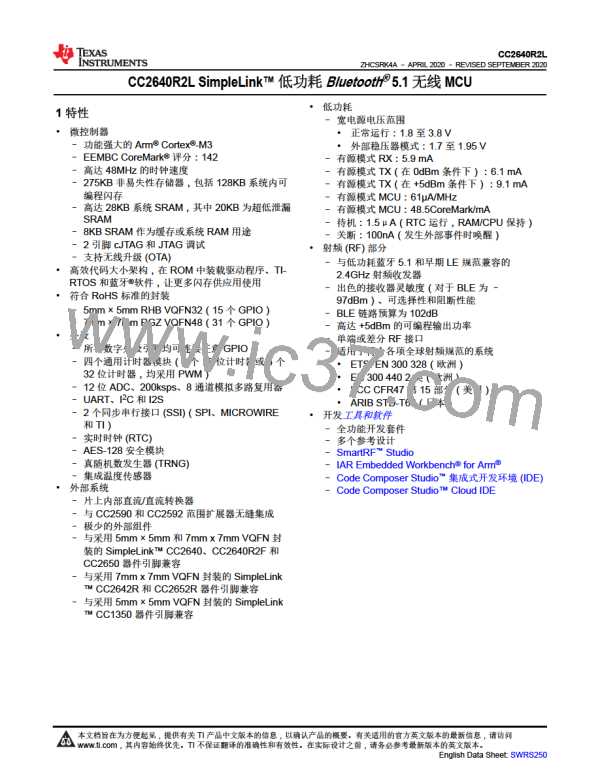CC2640R2L
ZHCSRK4A –APRIL 2020 –REVISED SEPTEMBER 2020
www.ti.com.cn
• Highly flexible and configurable channel operation of up to 32 channels
• Transfer modes:
– Memory-to-memory
– Memory-to-peripheral
– Peripheral-to-memory
– Peripheral-to-peripheral
• Data sizes of 8, 16, and 32 bits
The AON domain contains circuitry that is always enabled, except for in Shutdown (where the digital supply is
off). This circuitry includes the following:
• The RTC can be used to wake the device from any state where it is active. The RTC contains three compare
and one capture registers. With software support, the RTC can be used for clock and calendar operation. The
RTC is clocked from the 32-kHz RC oscillator or crystal. The RTC can also be compensated to tick at the
correct frequency even when the internal 32-kHz RC oscillator is used instead of a crystal.
• The battery monitor and temperature sensor are accessible by software and give a battery status indication
as well as a coarse temperature measure.
The ADC is a 12-bit, 200 ksamples per second (ksps) ADC with eight inputs and a built-in voltage reference. The
ADC can be triggered by many different sources, including timers, I/O pins, software, and the RTC.
9.10 Voltage Supply Domains
The CC2640R2L device can interface to two or three different voltage domains depending on the package type.
On-chip level converters ensure correct operation as long as the signal voltage on each input/output pin is set
with respect to the corresponding supply pin (VDDS, VDDS2 or VDDS3). 表9-2 lists the pin-to-VDDS mapping.
表9-2. Pin Function to VDDS Mapping Table
Package
VQFN 7 × 7 (RGZ)
VQFN 5 × 5 (RHB)
DIO 23–30
Reset_N
DIO 7–14
Reset_N
VDDS(1)
VDDS2
VDDS3
DIO 0–6
JTAG
DIO 0–11
DIO 12–22
N/A
JTAG
(1) VDDS_DCDC must be connected to VDDS on the PCB.
9.11 System Architecture
Depending on the product configuration, CC26xx can function either as a Wireless Network Processor (WNP—
an IC running the wireless protocol stack, with the application running on a separate MCU), or as a System-on-
Chip (SoC), with the application and protocol stack running on the Arm Cortex-M3 core inside the device.
In the first case, the external host MCU communicates with the device using SPI or UART. In the second case,
the application must be written according to the application framework supplied with the wireless protocol stack.
Copyright © 2023 Texas Instruments Incorporated
Submit Document Feedback
33

 TI [ TEXAS INSTRUMENTS ]
TI [ TEXAS INSTRUMENTS ]